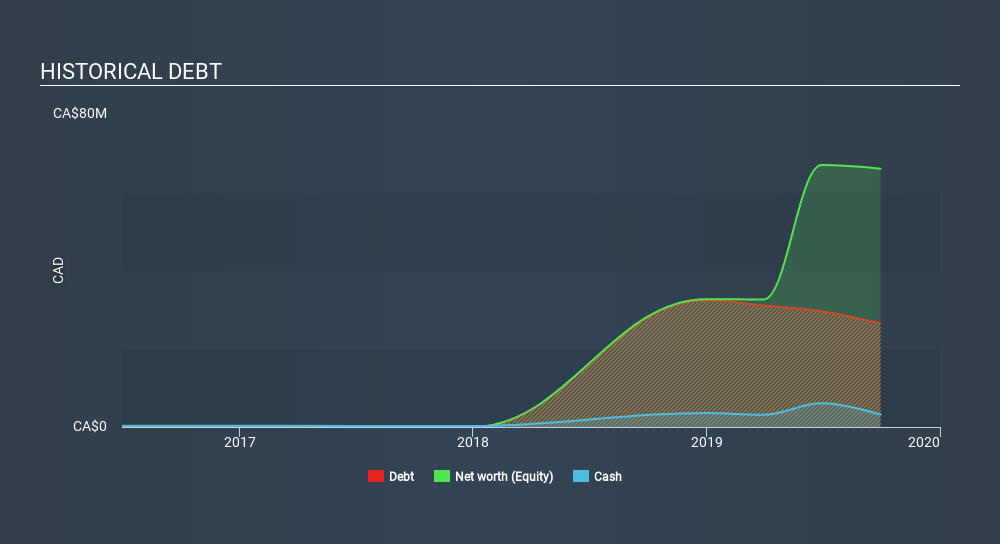
Some say volatility, rather than debt, is the best way to think about risk as an investor, but Warren Buffett famously said that 'Volatility is far from synonymous with risk'. So it seems the smart money knows that debt - which is usually involved in bankruptcies - is a very important factor, when you assess how risky a company is. We can see that Hut 8 Mining Corp. (TSE:HUT) does use debt in its business. But the real question is whether this debt is making the company risky.
When Is Debt A Problem?
Generally speaking, debt only becomes a real problem when a company can't easily pay it off, either by raising capital or with its own cash flow. If things get really bad, the lenders can take control of the business. While that is not too common, we often do see indebted companies permanently diluting shareholders because lenders force them to raise capital at a distressed price. By replacing dilution, though, debt can be an extremely good tool for businesses that need capital to invest in growth at high rates of return. When we examine debt levels, we first consider both cash and debt levels, together.
Check out our latest analysis for Hut 8 Mining
How Much Debt Does Hut 8 Mining Carry?
You can click the graphic below for the historical numbers, but it shows that Hut 8 Mining had CA$26.5m of debt in September 2019, down from CA$32.4m, one year before. However, it does have CA$3.18m in cash offsetting this, leading to net debt of about CA$23.3m.

How Healthy Is Hut 8 Mining's Balance Sheet?
We can see from the most recent balance sheet that Hut 8 Mining had liabilities of CA$7.71m falling due within a year, and liabilities of CA$22.5m due beyond that. Offsetting this, it had CA$3.18m in cash and CA$557.2k in receivables that were due within 12 months. So its liabilities outweigh the sum of its cash and (near-term) receivables by CA$26.5m.
While this might seem like a lot, it is not so bad since Hut 8 Mining has a market capitalization of CA$116.7m, and so it could probably strengthen its balance sheet by raising capital if it needed to. However, it is still worthwhile taking a close look at its ability to pay off debt. There's no doubt that we learn most about debt from the balance sheet. But it is Hut 8 Mining's earnings that will influence how the balance sheet holds up in the future. So if you're keen to discover more about its earnings, it might be worth checking out this graph of its long term earnings trend.
In the last year Hut 8 Mining wasn't profitable at an EBIT level, but managed to grow its revenue by 107%, to CA$80m. So there's no doubt that shareholders are cheering for growth
Caveat Emptor
While we can certainly savour Hut 8 Mining's tasty revenue growth, its negative earnings before interest and tax (EBIT) leaves a bitter aftertaste. To be specific the EBIT loss came in at CA$2.1m. When we look at that and recall the liabilities on its balance sheet, relative to cash, it seems unwise to us for the company to have any debt. Quite frankly we think the balance sheet is far from match-fit, although it could be improved with time. For example, we would not want to see a repeat of last year's loss of CA$91m. So we do think this stock is quite risky. When analysing debt levels, the balance sheet is the obvious place to start. However, not all investment risk resides within the balance sheet - far from it. For instance, we've identified 5 warning signs for Hut 8 Mining (1 is a bit concerning) you should be aware of.
If you're interested in investing in businesses that can grow profits without the burden of debt, then check out this free list of growing businesses that have net cash on the balance sheet.
If you spot an error that warrants correction, please contact the editor at editorial-team@simplywallst.com. This article by Simply Wall St is general in nature. It does not constitute a recommendation to buy or sell any stock, and does not take account of your objectives, or your financial situation. Simply Wall St has no position in the stocks mentioned.
We aim to bring you long-term focused research analysis driven by fundamental data. Note that our analysis may not factor in the latest price-sensitive company announcements or qualitative material. Thank you for reading.
Market Insights
Community Narratives




